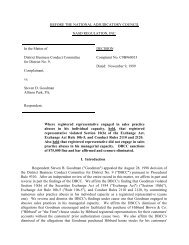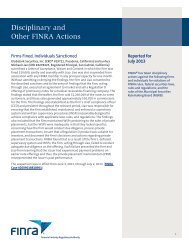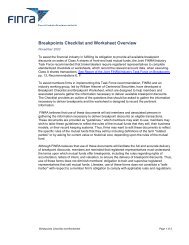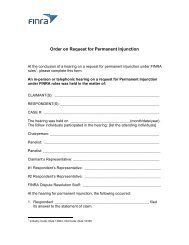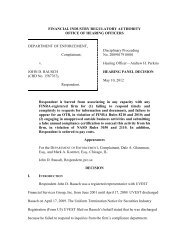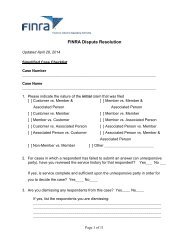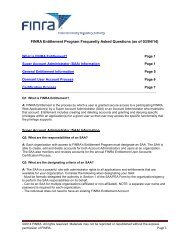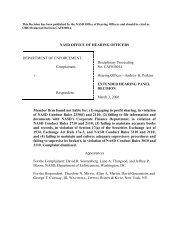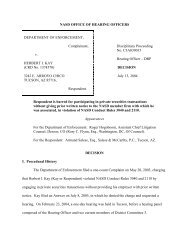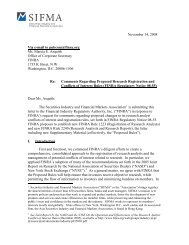In Our Best Interest: Women, Financial Literacy and Credit Card - finra
In Our Best Interest: Women, Financial Literacy and Credit Card - finra
In Our Best Interest: Women, Financial Literacy and Credit Card - finra
Create successful ePaper yourself
Turn your PDF publications into a flip-book with our unique Google optimized e-Paper software.
A REPORT FROM THE<br />
FINRA INVESTOR EDUCATION FOUNDATION<br />
<strong>In</strong>sights: American <strong>Financial</strong> Capability<br />
APRIL 2012<br />
Author:<br />
Gary R. Mottola, Ph.D.<br />
What’s <strong>In</strong>side:<br />
Summary 1<br />
Background 1<br />
Gender <strong>and</strong> <strong>Credit</strong> <strong>Card</strong><br />
Behavior 2<br />
<strong>Credit</strong> <strong>Card</strong> <strong>In</strong>terest Rates 4<br />
Implications 4<br />
References 4<br />
Appendix 5<br />
<strong>In</strong> <strong>Our</strong> <strong>Best</strong> <strong>In</strong>terest: <strong>Women</strong>, <strong>Financial</strong><br />
<strong>Literacy</strong> <strong>and</strong> <strong>Credit</strong> <strong>Card</strong> Behavior<br />
Summary<br />
Data from the FINRA <strong>In</strong>vestor Education National <strong>Financial</strong> Capability Study revealed that<br />
women with low levels of financial literacy were more likely to engage in costly credit<br />
card behaviors—like incurring late fees—than men with low financial literacy. There<br />
were, however, no differences in behavior between men <strong>and</strong> women with high financial<br />
literacy. These findings suggest that increasing financial literacy can improve credit card<br />
management <strong>and</strong> reduce or eliminate gender-based differences in credit card behavior.<br />
Background<br />
<strong>Women</strong> consistently score lower than men on measures of financial literacy, <strong>and</strong> this<br />
gender-based gap can negatively impact the financial well-being of women. 1 For example,<br />
financial literacy has been linked to several outcomes, including wealth accumulation,<br />
stock market participation, retirement planning <strong>and</strong> the use of high-cost alternative<br />
financial services like payday lending <strong>and</strong> auto title loans. 2 Less is known, however, about<br />
the relationship between gender <strong>and</strong> credit card behavior, <strong>and</strong> what role, if any, financial<br />
literacy plays in this relationship. 3<br />
Underst<strong>and</strong>ing credit card behavior among women is important because credit cards<br />
are pervasive in the United States. Over three-quarters of the population owns at least<br />
one card, <strong>and</strong>, on average, credit card users have 3.7 cards <strong>and</strong> an unpaid balance of over<br />
$5,600. 4 Given their widespread use, credit card mismanagement can have far reaching<br />
effects. Missed <strong>and</strong> late payments, as well as exceeding credit limits, can lead to higher<br />
fees, higher interest rates <strong>and</strong> lower credit scores. Similarly, failing to choose a card with a<br />
competitive interest rate <strong>and</strong> reasonable features can drive up borrowing costs.<br />
Using data from the 2009 FINRA <strong>In</strong>vestor Education Foundation National <strong>Financial</strong><br />
Capability Study (NFCS), we explored the relationships among gender, financial literacy<br />
<strong>and</strong> credit card management in greater detail. The 2009 NFCS (state-by-state version)<br />
is an online study that surveyed more than 28,000 respondents (approximately 500 per<br />
state, plus the District of Columbia) in 2009. 5 The sample used in this study was weighted<br />
to match the adult U.S. population (age 18 <strong>and</strong> up) on age by gender, ethnicity, education<br />
<strong>and</strong> census division. (Data from the U.S. Census Bureau’s 2008 American Community<br />
Survey were used to construct the weights.) However, as in all survey research, there are<br />
possible sources of error—such as coverage, nonresponse <strong>and</strong> measurement error—that<br />
could affect the results.<br />
1<br />
Fonseca, Mullen, Zamarro <strong>and</strong> Zissimpoulos (2010).<br />
2<br />
Lusardi (2011).<br />
3<br />
Allgood <strong>and</strong> Walstad (2011) examined the effects of financial knowledge on credit card behavior.<br />
4<br />
Foster, Meijer, Schuh <strong>and</strong> Zabek (2011); U.S. Census Bureau (2012).<br />
5<br />
For more information on the NFCS methodology, go to www.<strong>finra</strong>foundation.org/programs/capability.<br />
1<br />
INSIGHTS: AMERICAN FINANCIAL CAPABILITY—APRIL 2012
Gender <strong>and</strong> <strong>Credit</strong> <strong>Card</strong> Behavior<br />
Female respondents exhibited more costly credit card<br />
behavior than male respondents. For example, women were<br />
five percentage points more likely to carry a balance, four<br />
points more likely to pay the minimum payment on their<br />
cards <strong>and</strong> six points more likely to be charged a late fee<br />
(Figure 1).<br />
All of the differences in Figure 1 are statistically significant,<br />
but they are also meaningful on a relative basis as well. For<br />
example, when you consider that only 23 percent of male<br />
respondents were charged a late fee, the six percentage-point<br />
increase for women means that women are 26 percent more<br />
likely than men to be charged a late fee. Similarly, women<br />
exhibited fewer positive credit card behaviors than men;<br />
for instance, women were less likely to pay their balance in<br />
full <strong>and</strong> comparison shop for credit cards. One bright spot<br />
for women is that they were less likely than men to take a<br />
cash advance on their credit card, although it is unclear why<br />
women outperformed men in this one area.<br />
There are clearly gender-based differences in credit card<br />
behavior, but can financial literacy mitigate these differences<br />
And, do these gender-based differences persist even after<br />
accounting for other demographic characteristics For<br />
example, if we could compare men <strong>and</strong> women who were<br />
identical in many demographic respects—for instance,<br />
income, education level, age <strong>and</strong> race—would we still find<br />
credit card behavior differences between the sexes To<br />
answer these questions, we conducted an analysis that allows<br />
us to assess the impact of gender <strong>and</strong> financial literacy on<br />
the likelihood of engaging in two or more negative credit card<br />
behaviors—after accounting for the effects of other variables,<br />
or stated another way, all things being equal. 6<br />
<strong>Credit</strong> <strong>Card</strong> Behavior<br />
Relative<br />
Male Female Difference Difference<br />
Negative Behaviors<br />
Carried a Balance 55% 60% 5% 9%<br />
Paid Minimum 38% 42% 4% 11%<br />
Late Fee 23% 29% 6% 26%<br />
Over the Limit Fee 15% 16% 1% 7%<br />
Cash Advance 15% 12% -3% -20%<br />
Positive Behaviors<br />
Paid Balance in Full 45% 39% -6% -13%<br />
Comparison Shopped for <strong>Card</strong>s 37% 31% -6% -16%<br />
Multiple Problematic Behaviors<br />
Two or more problematic behaviors 33% 38% 5% 15%<br />
6<br />
We used a linear probability model to estimate the probability of engaging in two or more negative credit card behaviors. (Logistic regression yielded nearly identical<br />
results.) The model included the following variables: gender, financial literacy, age, minority status, income, presence of dependents in the household <strong>and</strong> income shock<br />
(i.e., a large, unexpected drop in income). Not engaging in a positive behavior was coded as a negative behavior.<br />
2<br />
INSIGHTS: AMERICAN FINANCIAL CAPABILITY—APRIL 2012
<strong>Our</strong> analysis revealed several interesting findings. First,<br />
the relationship between gender <strong>and</strong> credit card behavior<br />
is affected by financial literacy—that is, among men <strong>and</strong><br />
women with low levels of financial literacy, women are likely<br />
to engage in significantly more costly behaviors than men. 7<br />
Specifically, 29 percent of men with low levels of financial<br />
literacy are likely to engage in problematic credit card<br />
behaviors, but this value is 32 percent for women with low<br />
financial literacy—only a 3 percent absolute increase, but<br />
over a 10 percent relative increase (Figure 2). However, among<br />
men <strong>and</strong> women with high levels of financial literacy there<br />
are no differences in behavior between the sexes. Twentyfour<br />
percent of both men <strong>and</strong> women with high levels of<br />
financial literacy are likely to engage in problematic credit<br />
card behaviors. <strong>In</strong> other words, not only does high financial<br />
literacy appear to improve credit card behavior for both men<br />
<strong>and</strong> women, but it also appears to eliminate gender-based<br />
differences in credit card behavior.<br />
Another interpretation of Figure 2 is that women will<br />
benefit more from an improvement in financial literacy than<br />
men, <strong>and</strong> this can be seen if we present the same data in<br />
a different fashion. Figure 3 shows that 29 percent of men<br />
with low financial literacy are likely to engage in problematic<br />
credit card behaviors compared to 24 percent for men with<br />
high financial literacy—a 5 percentage point drop after<br />
adjusting for other demographic characteristics. For women,<br />
however, the difference between high <strong>and</strong> low financial<br />
literacy respondents was even larger. Specifically, 32 percent<br />
of women with low financial literacy are likely to engage<br />
in costly credit card behaviors compared to 24 percent for<br />
women with high levels of financial literacy—a drop of eight<br />
percentage points. <strong>In</strong> other words, while improving financial<br />
literacy will benefit both men <strong>and</strong> women, women’s credit<br />
card behavior will improve by 60 percent 8 more than men’s<br />
credit card behavior. 9<br />
Figure 2<br />
<strong>Credit</strong> <strong>Card</strong> Behavior by <strong>Financial</strong> <strong>Literacy</strong> <strong>and</strong> Gender<br />
Figure 3<br />
<strong>Credit</strong> <strong>Card</strong> Behavior by Gender <strong>and</strong> <strong>Financial</strong> <strong>Literacy</strong><br />
35%<br />
29%<br />
32%<br />
35%<br />
29%<br />
32%<br />
Probability of two or more costly<br />
credit card behavious<br />
24% 24%<br />
Probability of two or more costly<br />
credit card behavious<br />
24%<br />
24%<br />
0%<br />
Low <strong>Financial</strong> <strong>Literacy</strong><br />
High <strong>Financial</strong> <strong>Literacy</strong><br />
0%<br />
Male<br />
Female<br />
• Male<br />
• Female<br />
• Low <strong>Financial</strong> <strong>Literacy</strong><br />
• High <strong>Financial</strong> <strong>Literacy</strong><br />
7<br />
Respondents were separated into high <strong>and</strong> low financial literacy groups via a median split. Those who answered four or all five financial literacy questions correctly were<br />
coded as “high financial literacy” <strong>and</strong> all others were coded as “low financial literacy.”<br />
8<br />
60%=(8%-5%)/(5%)<br />
9<br />
This interaction effect was significant at the .05 alpha level in the regression analysis.<br />
3<br />
INSIGHTS: AMERICAN FINANCIAL CAPABILITY—APRIL 2012
<strong>Credit</strong> <strong>Card</strong> <strong>In</strong>terest Rates<br />
The findings to this point suggest that women engage<br />
in more costly credit card behaviors than men, <strong>and</strong> that<br />
increasing financial literacy can mitigate gender-based<br />
differences in credit card behavior. However, another<br />
interesting aspect of credit card usage is interest rates. Are<br />
gender <strong>and</strong> financial literacy related to credit card interest<br />
rates in the same fashion that they are related to credit card<br />
management<br />
Figure 4 shows predicted credit card interest rates for<br />
males <strong>and</strong> females by high <strong>and</strong> low financial literacy, after<br />
controlling for other demographic variables. 10 As seen in this<br />
figure, females pay half a percentage point more in credit card<br />
interest rates than men, regardless of financial literacy level. 11<br />
And both men <strong>and</strong> women with low levels of financial literacy<br />
pay more in credit card interest rates than those with high<br />
financial literacy. However, whereas high levels of financial<br />
literacy eliminated credit card behavioral differences between<br />
the sexes, interest rate differences between the sexes persist.<br />
It is not clear why financial literacy would mitigate gender<br />
differences in costly credit card behaviors but not differences<br />
in credit card interest rates, so more research is needed to<br />
better underst<strong>and</strong> this finding.<br />
Figure 4<br />
<strong>Credit</strong> <strong>Card</strong> <strong>In</strong>terest Rates by Gender <strong>and</strong> <strong>Financial</strong> <strong>Literacy</strong><br />
Low <strong>Financial</strong><br />
<strong>Literacy</strong><br />
High <strong>Financial</strong><br />
<strong>Literacy</strong><br />
Female 15.0% 14.7%<br />
Male 14.5% 14.1%<br />
Although the half percentage point spread in credit<br />
card interest rates between men <strong>and</strong> women is not a<br />
marked difference, over the course of a lifetime a female<br />
consumer could pay hundreds or thous<strong>and</strong>s of dollars<br />
more in borrowing costs relative to a male with the same<br />
demographic characteristics. 12<br />
Implications<br />
These findings suggest that increasing financial literacy<br />
among women <strong>and</strong> men may be a fruitful means of<br />
improving credit card behavior <strong>and</strong> reducing or eliminating<br />
gender-based differences in credit card behavior. Improving<br />
financial literacy could also result in lower credit card interest<br />
rates for both men <strong>and</strong> women. <strong>In</strong> addition, while this paper<br />
focused on gender <strong>and</strong> financial literacy, our analyses suggest<br />
that other variables may play a more pronounced role in<br />
affecting credit card behavior. For example, respondents<br />
reporting a sharp <strong>and</strong> unexpected drop in income experienced<br />
higher levels of costly credit card behaviors, as did minorities<br />
<strong>and</strong> low-income respondents, so additional research<br />
focusing on these variables could prove insightful. Last, the<br />
NFCS dataset used for this analysis also contains data on<br />
credit scores—an examination of the relationships among<br />
credit card behavior, credit scores <strong>and</strong> credit card interest<br />
rates would help shed additional light on the causes <strong>and</strong><br />
consequences of credit card mismanagement.<br />
References<br />
Alesina, Alberto <strong>and</strong> Francesca Lotti. 2008. “Do <strong>Women</strong> Pay<br />
More for <strong>Credit</strong> Evidence from Italy.” National Bureau of<br />
Economic Research Working Paper No. 14202.<br />
Allgood, Sam <strong>and</strong> William B. Walstad. 2011. “The Effects<br />
of Perceived <strong>and</strong> Actual <strong>Financial</strong> Knowledge on <strong>Credit</strong> <strong>Card</strong><br />
Behavior.” Networks <strong>Financial</strong> <strong>In</strong>stitute at <strong>In</strong>dian State<br />
University Working Paper 2011-WP-15.<br />
Fonseca, Raquel, Kathllen J. Mullen, Gema Zamarro <strong>and</strong><br />
Julie Zissimopoulos. 2010. “What Explains the Gender Gap in<br />
<strong>Financial</strong> <strong>Literacy</strong>” R<strong>and</strong> Labor <strong>and</strong> Population Working Paper<br />
Series, WR-762.<br />
Foster, Kevin, Erik Meijer, Scott Schuh <strong>and</strong> Michael A. Zabek.<br />
2011. “The 2009 Survey of Consumer Payment Choice.”<br />
Federal Reserve Bank of Boston Public Policy Discussion<br />
Paper No. 11-1.<br />
Lusardi, Annamaria. 2011. “American’s <strong>Financial</strong> Capability.”<br />
Pension Research Council Working Paper WP2011-02.<br />
U.S. Census Bureau. 2012. Statistical Abstract of the<br />
United States.<br />
10<br />
<strong>Credit</strong> card interest rates were predicted using OLS regression with the following variables: age, gender, minority status, income, presence of dependents in the<br />
household, education <strong>and</strong> financial literacy. The analysis is based on a subset sample of 8,850 respondents who provided their credit card interest rate.<br />
11<br />
Alesina <strong>and</strong> Lotti (2009) found that women pay more for credit in Italy.<br />
12<br />
For example, a half-point different in credit card interest rates on a balance of $5,600 over 50 years (with no additional purchases or payments) would result in an<br />
additional $1,600 in borrowing costs, assuming compounding interest.<br />
4<br />
INSIGHTS: AMERICAN FINANCIAL CAPABILITY—APRIL 2012
Appendix<br />
<strong>Financial</strong> <strong>Literacy</strong> Questions<br />
<strong>In</strong>terest Rate Calculation:<br />
“Suppose you had $100 in a savings account <strong>and</strong> the interest rate was 2% per year. After 5 years,<br />
how much do you think you would have in the account if you left the money to grow”<br />
More than $102<br />
Exactly $102<br />
Less than $102<br />
Don’t know<br />
Prefer not to say<br />
<strong>In</strong>flation:<br />
“Imagine that the interest rate on your savings account was 1% per year <strong>and</strong> inflation was 2% per year.<br />
After 1 year, how much would you be able to buy with the money in this account”<br />
More than today<br />
Exactly the same<br />
Less than today<br />
Don’t know<br />
Prefer not to say<br />
Bond prices <strong>and</strong> <strong>In</strong>terest Rates:<br />
“If interest rates rise, what will typically happen to bond prices”<br />
They will rise<br />
They will fall<br />
They will stay the same<br />
There is no relationship between bond prices <strong>and</strong> the interest rate<br />
Don’t know<br />
Prefer not to say<br />
Mortgage <strong>In</strong>terest Payments <strong>and</strong> Maturity:<br />
“A 15-year mortgage typically requires higher monthly payments than a 30-year mortgage,<br />
but the total interest paid over the life of the loan will be less.”<br />
True<br />
False<br />
Don’t know<br />
Prefer not to say<br />
Risk Diversification:<br />
“Buying a single company’s stock usually provides a safer return than a stock mutual fund.”<br />
True<br />
False<br />
Don’t know<br />
Prefer not to say<br />
5<br />
INSIGHTS: AMERICAN FINANCIAL CAPABILITY—APRIL 2012
About the FINRA <strong>In</strong>vestor Education<br />
Foundation:<br />
The mission of the FINRA <strong>In</strong>vestor<br />
Education Foundation is to provide<br />
underserved Americans with the<br />
knowledge, skills <strong>and</strong> tools necessary for<br />
financial success throughout life. The<br />
FINRA Foundation envisions a society<br />
characterized by universal financial<br />
literacy.<br />
Established in 2003, the FINRA<br />
Foundation supports innovative research<br />
<strong>and</strong> educational projects aimed at<br />
segments of the investing public that<br />
could benefit from additional resources.<br />
These resources come in various forms.<br />
<strong>Our</strong> grants allow researchers to explore<br />
investor behavior <strong>and</strong> develop practical<br />
ways to avoid costly mistakes <strong>and</strong><br />
prepare for the future. Grant funding<br />
also helps nonprofit organizations<br />
ensure that reliable financial <strong>and</strong><br />
investor education is available to all<br />
who need it, when they need it—at the<br />
workplace, online 24/7, or wherever it’s<br />
most effective.<br />
By sharing research <strong>and</strong> tools broadly,<br />
the FINRA Foundation adds to the<br />
collective wisdom about how best to<br />
help investors. Such information also<br />
shapes our directed programs. When<br />
we work on behalf of military service<br />
members <strong>and</strong> their families, with older<br />
Americans nearing or in retirement, or<br />
with students in all parts of the country,<br />
we have the opportunity to apply the<br />
latest research <strong>and</strong> adapt <strong>In</strong>novative<br />
strategies to their circumstances <strong>and</strong><br />
needs.<br />
<strong>Our</strong> goal is to reach more <strong>and</strong> more<br />
investors each year, educate them on<br />
their own terms, <strong>and</strong> teach them how<br />
to protect themselves in a world that is<br />
complex <strong>and</strong> dynamic.<br />
Foundation Partnerships:<br />
The FINRA Foundation maintains<br />
partnerships with leading nonprofits<br />
<strong>and</strong> agencies to ensure best practices<br />
in grant making <strong>and</strong> financial literacy<br />
education across the lifespan. <strong>In</strong>deed,<br />
partnerships are the strength of<br />
the FINRA Foundation’s grants <strong>and</strong><br />
projects. By collaborating with others,<br />
the FINRA Foundation maximizes<br />
the value of every dollar spent.<br />
<strong>Our</strong> partners, in both the public<br />
<strong>and</strong> private sectors, help us reach<br />
individuals <strong>and</strong> families who need<br />
thoughtful, unbiased guidance.<br />
FINRA <strong>In</strong>vestor Education Foundation<br />
National <strong>Financial</strong> Capability Study:<br />
<strong>In</strong> consultation with the U.S.<br />
Department of the Treasury <strong>and</strong><br />
the President’s Advisory Council on<br />
<strong>Financial</strong> <strong>Literacy</strong>, the FINRA <strong>In</strong>vestor<br />
Education Foundation commissioned<br />
a national study of the financial<br />
capability of American adults. The<br />
objectives were to benchmark key<br />
indicators of financial capability<br />
<strong>and</strong> evaluate how these indicators<br />
vary with underlying demographic,<br />
behavioral, attitudinal <strong>and</strong> financial<br />
literacy characteristics. Reports <strong>and</strong><br />
data from this study were published<br />
in 2009 in 2010, <strong>and</strong> can be found at<br />
www.usfinancialcapability.org. The<br />
FINRA Foundation is conducting a<br />
second wave of the study this year,<br />
<strong>and</strong> results will be available in<br />
early 2013.<br />
About the <strong>Financial</strong> <strong>In</strong>dustry<br />
Regulatory Authority:<br />
FINRA, the <strong>Financial</strong> <strong>In</strong>dustry Regulatory<br />
Authority, is an independent regulatory<br />
organization empowered by the federal<br />
government to ensure that America’s<br />
90 million investors are protected. <strong>Our</strong><br />
independent regulation plays a critical<br />
role in America’s financial system—at<br />
no cost to taxpayers. We register brokers<br />
<strong>and</strong> brokerage firms, write <strong>and</strong> enforce<br />
rules governing their activities, examine<br />
firms for compliance, <strong>and</strong> foster market<br />
transparency <strong>and</strong> educate investors. For<br />
more information, visit www.<strong>finra</strong>.org.<br />
<strong>In</strong>sights: American <strong>Financial</strong> Capability<br />
is published by the FINRA <strong>In</strong>vestor<br />
Education Foundation. Send all<br />
correspondence to:<br />
Gary Mottola, Associate Director<br />
Office of <strong>In</strong>vestor Education<br />
FINRA <strong>In</strong>vestor Education Foundation<br />
1735 K Street, NW<br />
Washington, DC 20006-1506<br />
Or call (202) 728-8351.<br />
1735 K Street, NW<br />
Washington, DC 20006-1506<br />
www.<strong>finra</strong>foundation.org<br />
© FINRA <strong>In</strong>vestor Education Foundation.<br />
All rights reserved. FINRA is a registered<br />
trademark of <strong>Financial</strong> <strong>In</strong>dustry Regulatory<br />
Authority.<br />
12_0032.1—04/12<br />
6<br />
INSIGHTS: AMERICAN FINANCIAL CAPABILITY—APRIL 2012



